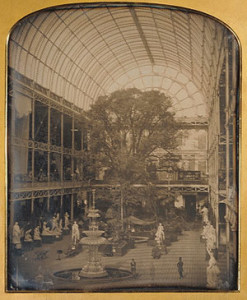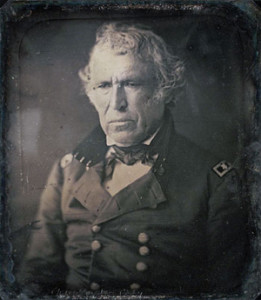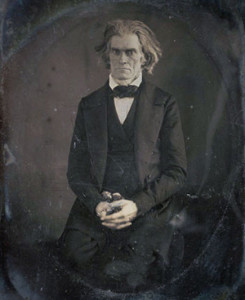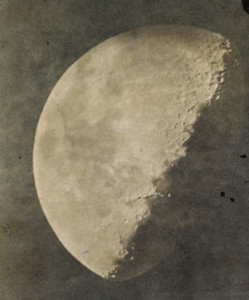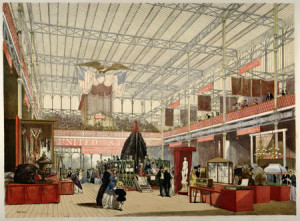American daguerreotypes at the Great Exhibition
In the spring of 1851, the British government completed construction of the largest glass box in the history of the world. Occupying this million-square-foot “Crystal Palace” was an equally unprecedented display of the world’s raw materials, machinery, manufactures, and fine arts: the Exhibition of the Works of Industry of All Nations. A distillation of the nineteenth century’s obsession with progress, the Great Exhibition (as it came to be known) presented more than one hundred thousand items from around the world. Forty nations submitted examples of things made or found within their boundaries: from accordions to power looms to huge pieces of zinc ore, the Great Exhibition offered its visitors an encyclopedic tour of the known and built worlds.
A major motive for organizing the exhibition was the impulse to collect and compare versions of similar products and technologies in the interest of setting a world standard—for steam presses and textile weaving, as much as for soap and cheese. The sheer number of items to judge and the strong potential for accusations of bias in the awarding of prize medals occasioned significant procedural hand wringing. Although the entries were grouped in the Crystal Palace by their country of origin, multinational committees of scientists, artists, and gentlemen were specifically directed to award medals “without reference to Nationality.” The official instructions to the judges made it clear that “[t]he Medals will be awarded for excellence only, without reference to countries, the Exhibition being considered as a whole, and not consisting of the produce of different nations.” In spite of these provisos, the exhibition was an extravagant pageant of nationalism: as each of England’s invited guests understood, their country’s industrial and cultural achievements would be on view to the world, and its global standing and national pride, at stake.
For the United States, the Great Exhibition presented a significant opportunity to display the fruits of its independence from England and the virtues of a democratic republic to the rest of the world. By showcasing its natural resources, people, manufactures, and politics, the young nation sought to establish itself as at least equal, if not superior, to the countries of the Old World and to distance itself from their colonies. A circular from the United States Central Committee—appointed by the Washington-based National Institute for the Promotion of Science and the Arts and approved by the Secretary of State for selecting and sending goods to the Exhibition—indicated that America’s produce should illustrate that the “human mind in the United States[,] being as free and untrammeled as it possibly can be, takes everything within its grasp, and knows no limits but those prescribed by nature and her laws.”
If the stakes were high for the Central Committee, they were even higher in the popular press, which understood that the things on display would necessarily advance narratives of the United States’ exceptional founding, progress, and status as a nation and culture. The New-York Herald‘s declaration is representative: the exhibition “is of more importance to us politically and commercially, than to any other nation.” The same article manifests a pronounced sensitivity to lingering European impressions that the United States produced better raw materials than finished goods and that it valued industry over art, emphasizing the exhibition as the “first opportunity” that the United States had “of laying before the world [its] productions of art” and insisting that “it should not be passed lightly by.” With its best wares gleaming in the light of the Crystal Palace, the article anticipated, America would be able to show the world “that we not only produce cotton, iron, coal, copper and gold in greater abundances than any other nation, but that we can work them up into manufactures often equally, sometimes surpassing the oldest nations in a perfection and with a facility unknown to them.” Six months before the fair’s opening, the Springfield (Mass.) Republican predicted that the “Industrial Exhibition of 1851, to come off in London … will be a great test, full of glorious meaning in truth, and inevitable in the development of facts instructive in the morals, systems of religion, modes of government, and intellectual progress of every nation which it may represent … If we mistake not, the English will learn some important lessons from their western child, whom they still associate with savage life and whom many among them regard with dignified superciliousness.”
As these excerpts only begin to suggest, in advance of the fair’s opening, American newspapers themselves were transformed into a great printed exhibition, assuming postures that were both aggrandizing and defensive. Nationalists with the bully pulpit of the press were anxious to drive home the point to the entire nation that it had more to prove and to lose at the Great Exhibition with the world watching. At the same time, they aimed to rally Americans with the cry that the young nation could teach Old Europe a lesson or two about the industrial age on its own turf.
Soon after the Exhibition’s May 1 opening, news of its proceedings made its way to the United States. American newspapers and magazines printed accounts of the Crystal Palace’s brilliance and the modern marvels within (fig. 1). Initial reports of America’s showing were bleak. Unlike other countries, the United States’ government had not overseen the necessary preparations for the exhibition. This left each state’s committees and subcommittees—acting independently of each other without any central oversight—to select, transport, and display the thousands of entries from different states, cities, companies, and individuals. Once the resulting entries reached London, the lack of coordination back at home showed. The Central Committee had significantly overestimated the amount of space that would be needed to show off American wares. Spreading out the various items to fill up the empty space did little to disguise the error. The satirical English magazine Punch took up the problem with acerbic glee, remarking of the prideful pasteboard eagle hanging over the American section, “No eagle, asking of itself where it should dine, and hovering in space without a visible mouthful, could represent the grandeur of contemplative solitude better than is shown by the United States’ Eagle in the firmament of Mr. Paxton’s Crystal.” The (Washington) National Intelligencer‘s exhibition correspondent reported that the “importance of this Exhibition has been greatly underrated by us … I fear we shall be very badly beaten; and I advise any one who intends coming here in the expectation that this Exhibition is going to raise our country in the eyes of the world to stay at home.”
The majority of items on display did little to change the persistent characterization of America as chiefly a source for mineral and agricultural raw material and utilitarian manufactures; as one London paper remarked, “the articles sent from our kindred across the ocean seem almost exclusively to be matters of utility, with which taste and ornament have had nothing to do.” Even the successful U.S. entries were rather dull: though Samuel Colt’s revolvers and Hiram Powers’s statue “The Greek Slave” caused some minor sensation, it was objects like Cyrus McCormick’s reaper and Gail Borden’s patented “meat biscuits” (or “Portable Dessicated Soup Bread,” as they were even less appetizingly called) that judges and spectators singled out for special recognition (fig. 2).
This state of affairs dismayed even the normally irrepressible Horace Greeley, founder and editor of the New-York Tribune and chairman of the jury for the exhibition’s class XXII (Iron and General Hardware). In his dispatch from opening day, Greeley readily admitted “[o]ur manufactures are in many departments grossly deficient, in others inferior to the best rival productions of Europe.” He went on to lament that “few of these are goods which make much show in a Fair; three cases of Parisian gewgaws will outshine in an exhibition a million dollars’ worth of admirable and cheap” American fabrics. Lest his readers become too discouraged, however, Greeley turned to what was emerging as a bright spot in the U.S. department, if not an outright American triumph. “In Daguerreotypes,” he proudly announced, “it seems to be conceded that we beat the world … England is no where in comparison—and our Daguerreotypists make a great show here.” Confirming this success, the Scientific American reported from the exhibition later that month, “The American daguerreotypes are very fine, and do honor to our country. They have not their equals in light or shade. There are better colored daguerreotypes in Paris and even London, but none of such a rich and full tone perfection in chiara oscuro.”
In the written record of the exhibition—in the popular press and in the medal juries’ official reports—it is America’s daguerreotypes that came to be celebrated as incontrovertible proof of not only the nation’s success at the fair but also its industrial, scientific, artistic, and political prosperity. Daguerreotypy was the first form of photography, invented in France and announced to the world in 1839. Named after one of the process’s discoverers, Louis Jacques Mandé Daguerre, daguerreotypes were also called “sun pictures” because their lifelike images resulted from the direct exposure of a mirror-like, silver-coated, copper plate to sunlight. Unlike later forms of negative-to-positive photography, each daguerreotype was necessarily unique, making it a precious, yet affordable medium of imaging. Attracted by these qualities, Americans took up the daguerreotype with tremendous enthusiasm and in unrivalled numbers. By the 1850s, daguerreotypes were being made by the millions in lavish big-city studios, in refitted wagons that brought itinerant daguerreotypists to small towns, and everywhere in between.
At the Great Exhibition, the different types of photography on display, including daguerreotypes, were classed as “philosophical instruments and processes,” both to downplay their resemblance to painting, which had been disallowed in the exhibition as not advancing industrial knowledge, and to emphasize the knowledge of various physical sciences necessary to producing any type of photograph. The multinational jury of scientists and artists for class X—which included photography among other instruments such as telescopes, galvanic batteries, and coin weighing machines—also wanted to emphasize photography’s significant scientific uses as much as, if not more than, its virtues as a medium for portraiture. Even so, the jury could not overlook the use to which the majority of the different entries were put, concluding “for daguerreotype portraits, America stands prominently forward … her works, with few exceptions, reject all accessories, present a faithful transcript of the subject and yield to none in excellence of execution.” Greeley proudly trumpeted to his U.S. readers, “Our Daguerreotypists make a great show here.” Even the more critical voices in the British press found in American daguerreotypy something worthy of praise beneath the pasteboard eagle. “Within the shadow of the eagle and the striped banner we find no lights too white and no shadows too dark; they dissolve, as in Nature, one into the other, in the most harmonious and truthful manner—and the result is more perfect pictures.”
What made these examples of the first photographic imaging process so significant to both the exhibition’s judges and the American press seeking an unimpeachable sign of both the technical and moral accomplishments of America’s industry? The answers can be found in antebellum American print culture. From the daguerreotype’s introduction in 1839 through the Great Exhibition, newspapers and magazines throughout the country regularly celebrated daguerreotypy as a powerful combination of art and science capable of producing images of unprecedented representational accuracy, as well as propagating American ideology. Even though the process had been discovered in France, American inventors, artists, and casual experimenters immediately learned Daguerre’s complicated process and began working to improve upon it. Newspapers and magazines featured news of the latest innovations, including techniques for shortening exposure times, enhancing and permanently fixing the image on the plate, and posing sitters to ensure their satisfaction with their portraits. In addition to such technical information about the process, short stories published alongside the latest news dramatized the daguerreian portrait’s fidelity in capturing its subject’s inner character as well as his or her appearance. Periodicals also commonly included stories that celebrated the daguerreotype’s impact on American society, praising it as the first truly democratic form of portraiture because it could be made so much more cheaply and quickly than a painting.
A few examples from the substantial archive of such writings bring this picture into focus. Shortly after its introduction in 1839, Edgar Allan Poe wrote in the Southern Literary Messenger that the daguerreotype “is infinitely (we use the term advisedly) is infinitely more accurate in its representation than any painting by human hands … the closest scrutiny of the photogenic drawing discloses only a more absolute truth, a more perfect identity of aspect with the thing represented. The variations of shade, and the gradations of both linear and aerial perspective are those of truth itself in the supremeness of perfection.” Because the daguerreian camera was capable of registering everything in its view in such exact detail, many came to believe that it also could manifest the deepest qualities of its human subjects’ characters. Of the numerous “advantages resulting from this novel art,” an article in Littell’s Living Age magazine declared in 1846, “The aid which it affords to the successful study of human nature, is among the most important. Daguerreotypes properly regarded, are the indices of human character.” Available for as little as ten cents, they imaged all types of human characters. In Godey’s Lady’s Book, the popular writer T. S. Arthur celebrated this fulfillment of a representative daguerreian democracy in America at the end of the technology’s first decade. “In our great cities, a Daguerreotypist is to be found in almost every square; and there is scarcely a county in any state that has not one or more of these industrious individuals busy at work in catching ‘the shadow’ ere the ‘substance fade.’ A few years ago it was not every man who could afford a likeness of himself, his wife or his children; these were luxuries known to those only who had money to spare; now it is hard to find the man who has not gone through the ‘operator’s’ hands from once to half-a-dozen times, or who has not the shadowy faces of his wife and children done up in purple morocco and velvet, together or singly, among his household treasures. Truly the sunbeam art is a most wonderful one, and the public feel it is a great benefit!”
By the Great Exhibition of 1851, then, the popular press had made a thorough case for the daguerreotype’s “Americanness.” By insistently linking the distinctive capacities of the daguerreotype to what they sought to establish as America’s exceptional values, virtues, and progress, antebellum newspapers and magazines effectively campaigned for American daguerreotypes as capturing the national character more faithfully than any other artifact of the industrial age.
There was some truth to the exceptionalism emphasized in these reports. What began as a scientific and artistic curiosity had become a full-fledged industry in the United States by midcentury. According to one estimate, by 1853, nearly three million daguerreotypes were being taken each year in the United States alone, and some seventeen thousand Americans worked as daguerreotypists or in manufacturing related to daguerreotypy to meet this demand. By the time of the Great Exhibition, the rest of the world, including France, looked to America for its daguerreian cameras and lenses, its processes and materials for coating and buffing the image plate, its chemicals for developing and fixing the image, its paints and brushes used to apply color to the silver toned images, its cases to protect and enhance the fragile pictures, and its machinery used to manufacture these various necessities. As the daguerreotypist and Photographic Art-Journaleditor Henry Hunt Snelling declared in his “retrospective view of the Daguerrean art in the United States” in mid-1851, “we cannot feel otherwise than proud of the high state of perfection to which it has been brought by the American Photographist. The last five years have established the fact all over the world, that the American Daguerreotypes surpass those of all other countries, not only for the beauty of their finish but the taste of their execution.”
Indeed, The Official Descriptive and Illustrated Catalogue of the Great Exhibition offers a similar narrative of America’s exceptional accomplishments in daguerreotypy. “The Americans, from the first announcement of the wonderful art of sun-painting, have zealously made the subject one of much patient experiment. The first portraits from life were taken by the daguerreotype, in New York, and a variety of valuable manipulatory processes have originated in that country. The success with which the art is practiced, and the degree of perfection to which it has been brought, may be estimated by the specimens exhibited by various artists.”
In the companion volume of the exhibition juries’ reports, published to provide eager nations, entrants, and the public with lengthier explanations of how the juries had awarded their medals, the British astronomer and jury member James Glaisher reported in greater detail the findings of the class X judges with respect to daguerreotypy. “On examining the daguerreotypes contributed by the United States,” Glaisher wrote, “every observer must be struck with their beauty of execution, the broad and well-toned masses of light and shade, and the total absence of all glare, which render them so superior to many works of this class.”
Yet Glaisher was also quick to temper the jury’s praise. His report declares, “It is but fair to our own photographists to observe, that much as America has produced, and excellent as are her works, every effort has been seconded by all that climate and the purest of atmospheres could effect; and when we consider how important an element of the process is a clear atmosphere, we must be careful not to overrate that superiority of execution which America certainly manifests.” Glaisher’s backhanded compliment both limited the impact of praise the world’s most respected scientists and artists would give to America’s ardent nationalism and defended the work of the British daguerreotypists. As the jurors saw it, it was precisely the lack of American industrial progress that made its daguerreotypes so good: comparatively unfouled by factory smoke, American air did not interfere with the light essential to daguerreotypy. With this conclusion, the jury’s report effectively displaced America’s industry in favor of its environment as the secret of its daguerreotypes’ success: in the eyes of leading scientists and artists, these distinctive images derived their Americanness more from where they were made than how they were made.
The jury was also quick to foreclose the possibility that the makers of America’s daguerreian portraits be viewed as artists and that their subjects be seen to manifest uniquely American characters. The New York daguerreotypist Martin M. Lawrence’s entries, “two large portraits of General J. Watson and W. Bryant, Esq.,” are mentioned as “deserv[ing] particular commendation” not for whom they showed but for how the portraits showed them. The focus was purely technical. “Notwithstanding their large size, they are, throughout, perfectly in focus, and are beautifully finished in all their details.” Similarly, the portraits submitted by Mathew Brady were commended for the way that they “stand forward in bold relief upon a plain background.” “The portraits of General Taylor, Calhoun, General Cass, and James Perry, are strikingly excellent; but all are so good that selection is almost impossible,” the report concluded of Brady’s showing (figs. 3 and 4). Unacknowledged was the place of these portraits in Brady’s Gallery of Illustrious Americans—a collection of “some of the most distinguished men of this country,” exhibited to the public (for a fee) at his New York studio and engraved and published together as a collectible book in 1850. By contrast, the United States Democratic Reviewproclaimed Brady’s accomplishment in explicitly nationalist terms. “No such portraits have ever been made of our public men, and better ones could not be desired.” For making such admirable images of the most venerable Americans available to posterity, the Review deemed Brady’s Gallery “the most magnificent national work ever published” and declared that “[e]very American should be proud of such a publication.”
The jury reserved its highest praise for a daguerreotype of the moon taken by John A. Whipple of Boston (fig. 5). Given that the judges were some of the day’s leading astronomers and opticians, their bestowal of their “highest commendation” and a prize medal on images that advanced the world’s scientific knowledge is not particularly surprising. The report declared the image to be “one of the most satisfactory attempts that has yet been made to realise, by a photographic process, the telescopic appearance of a heavenly body, and must be regarded as indicating the commencement of a new era in astronomical representation.”
What is striking in the report is its particular aversion to what Glaisher described as “theatrical” and “allegorical” daguerreotypes. Illustrations of the Lord’s Prayer submitted by J. J. E. Mayall and a series of portraits by the Meade Brothers that featured sitters in costumes and settings representing Europe, Asia, Africa, and America were particularly criticized by the judges as inferior to entries in which more attention is given to form than to content. Though these images seem to have been lost to time, descriptions of their appearance remain. Mayall described his daguerreotype representing the “Our Father which art in Heaven” portion of the prayer as featuring “a Lady on her knees before the Altar” with “her eyes directed to the Catholic emblem of the Redeemer, the Saviour on the Cross” and a “pure expression of humility and penitence in the countenance and attitude.” His “Give us this Day our Daily Bread” pictured “a way-worn Pilgrim, with a staff in hand, weary with fatigue … receiving two loaves from the hands of a beautiful child.” Following the stereotypical conventions and racialist thought of the era, the Meade Brothers’ allegorical portraits of the “four quarters of the world” represented Europe as “a beautiful group [of sitters] surrounded by the arts”; Asia in the form of “an Asiatic in costume, on a divan, cross-legged, with a pipe, etc.”; Africa as “two negroes naked, excepting a tunic from the waist to the knees”; and America as “a group of Indians.” Only mentioning without describing these images, the jury’s report gave “greater credit” to the “delicacy of execution, harmonious distribution of light and shade,” and the “artistic effect” of Mayall’s and the Meades’s ordinary portraits. This jury, the report made clear, would not reward America for any story that its pictures wanted to tell, either in its allegorical daguerreotypes or in daguerreotypy itself as an allegory of the young nation’s achievements.
Greeley, reflecting on the exhibition in 1853, provided his own take on the jury’s report in light of what he has seen and wanted America and the rest of the world to see. He wrote,
In contrasting the specimens of [daguerreotypy] which are taken here with those taken in European countries, the excellence of American pictures is evident, which is to be accounted for by several reasons. In the first place, American skies are freer from fogs and clouds—from bituminous coal not being much used, the atmosphere of our cities is free from smoke, at least upon the Atlantic coasts. Then the chemicals and processes are, generally speaking, of a more sensitive character, and the apparatus [camera] is more convenient and suitable than that of Europe. Our little inventions come into play and aid in saving time and developing a good picture; and last, though perhaps not least, our people are readier in picking up processes and acquiring the mastery of the art than our trans-Atlantic rivals. Not that we understand the science better, but the details of the art are acquired in a shorter time by us, while the enormous practice which our operators enjoy combines to render the daguerreotype a necessary contributor to the comforts of life.
In his attempt to have the last word on what is winning about American daguerreotypes, Greeley turned the jury’s backhanded compliment to America’s atmosphere into a jab at industrial England’s pollution. If Glaisher would not recognize America’s industry in the jury’s report, then Greeley would imply that smoky skies are a more accurate representation of England’s industry than the gleaming Crystal Palace. And he would insist that the “superiority of execution” in the United States’ daguerreotypes could not be “overrated,” as the jury feared. Americans, Greeley contended, were superior in every aspect of the daguerreotype’s execution—they used better cameras, materials, and methods and, most importantly, they mastered the art more quickly through economy of scale. With this Greeley implied that the United States’ successful execution of this mechanical art is a consequence of its government, people, industry, and imagination. In Greeley’s report, democracy and daguerreotypy better approximated all that was real and true than any other forms of representation. Thus he concluded, “If there be any one department in the whole building which is peculiarly American, and in which the country shines preeminent, it is in that of Daguerreotypes.” Charles T. Rodgers came to a similarly nationalist conclusion a year before in his boldly titled book American Superiority at the World’s Fair. “We may congratulate ourselves on having made signal triumph in just those arts which most distinguish civilized man from the savage; and in having lost honor only in those arts which most distinguish a luxurious nation from the hardy energy of practical workers” (fig. 6)
Yet despite the best efforts of America’s daguerreotypists and its press, the exhibition jury’s report ultimately produced the most realistic picture of early photography in the industrial age by emphasizing what was to be anticipated from future processes and applications over what had been achieved. “That photography is yet in its infancy,” Glaisher wrote, “there can be little doubt; and it is more than probable that its present application, (which we believe to be well represented in the Exhibition), is no more its ultimatum than were the first applications of the telescope.” In 1851, the United States had accomplished more than any other country with the daguerreotype; by 1855, the process would be mostly obsolete. With the close of the exhibition in October of 1851, America would have to decide between resting on its recently won laurels or applying its supposedly characteristic industry to keep up with the rest of a world that was already moving beyond daguerreotypy to other photographic processes.
Less than a year later, the American Photographic Art-Journal looked to the future by sounding a more fraternal note in a poem on the art’s prospects.
Franklin brought down the lightning from the clouds,
Morse bade it act along the trembling wire;
The trump of Fame their praises gave aloud,
And others with the same high thoughts inspire.
Daguerre arose—his visionary scheme
Was viewed at first with jeers, derision, scorn,
Conquered at last by the grand power supreme
Of god-like mind—another art was born.
In mists the clouds dissolved like morning dew,
The world rejoiced to see the victory won;
With admiration, wonder, now we view
The effect produced by Nature’s God, the Sun.
The mantle from the great inventor flown,
With tenfold splendor on his pupils fell!
France, England, and America have shown
The bright invention has succeeded well.
Go on, young brothers, in your great career,
With others in the art, joined heart and hand;
Be all improvements given with friendly cheer,
“Divided ye may fall—United ye must stand!”
Photography, the poem both insists and predicts, will progress as a pageant of international cooperation to rival the Great Exhibition itself.
Further Reading:
The United States’ participation in the Great Exhibition of 1851 has received surprisingly little scholarly attention. The most thorough treatment remains Robert F. Dalzell Jr.’s Amherst College honors thesis, published as American Participation in the Great Exhibition of 1851 (Amherst, Mass., 1960). For a general history of the exhibition, see John R. Davis, The Great Exhibition (Gloucestershire, England, 1999). On the significance of the daguerreotype in American culture, Richard Rudisill’s Mirror Image: The Influence of the Daguerreotype on American Society (Albuquerque, 1971) is seminal; see also Alan Trachtenberg, Reading American Photographs: Images As History, Mathew Brady to Walker Evans (New York, 1989). For discussions of America’s daguerreotypes and other entries at the exhibition, the nineteenth-century texts, several of which are available via Google Books, reward reading. See the Official Descriptive and Illustrated Catalogue [of the] Great Exhibition of the Works of Industry of All Nations, 1851 (London, 1851) and the Reports By the Juries on the Subjects in the Thirty Classes Into Which the Exhibition Was Divided (London, 1852); The Journal of the Great Exhibition of 1851 (London, 1851); Horace Greeley’s Glances At Europe (New York, 1851); Art and Industry as Represented in the Exhibition at the Crystal Palace (New York, 1853); Charles T. Rodgers’s American Superiority at the World’s Fair (Philadelphia, 1852); and Henry Howe’s Adventures and Achievements of Americans (Cincinnati and New York, 1859). Mayall’s description of his daguerreotype illustrations of the Lord’s Prayer is quoted in Helmut Gernsheim’s Creative Photography: Aesthetic Trends, 1839-1960 (New York, 1991). The review of Brady’s Gallery of Illustrious Americans can be found in the January 1851 issue of the United States Democratic Review. The details of the Meade Brothers’ allegorical portraits and the concluding poem of this essay both come from the May 1852 issue of the Photographic Art-Journal.
This article originally appeared in issue 9.4 (July, 2009).
Marcy J. Dinius is an assistant professor of English at the University of Delaware. She is completing a book manuscript titled The Camera and the Pen: American Literature and Culture in the Daguerreian Age as a John W. Kluge Fellow at the Library of Congress.



